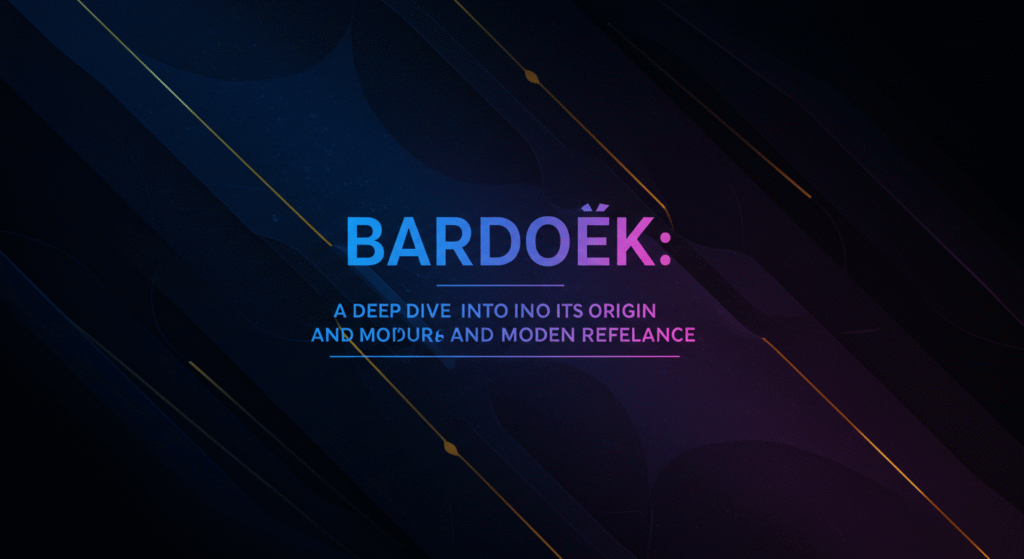The term Bardoek has sparked growing interest among artists, philosophers, and digital thinkers worldwide. Though its exact origin remains somewhat obscure, Bardoek symbolizes transformation, creativity, and the bridge between reality and imagination. In a world driven by innovation and reinterpretation of traditional concepts, Bardoek has evolved into a term representing modern artistic expression and the fluid nature of identity.
At its core, Bardoek stands for the intersection of human consciousness and creative experimentation — a unique idea that continues to inspire various cultural and artistic movements.
The Origin and Concept of Bardoek
The concept of Bardoek traces its roots to abstract artistic interpretations and philosophical thought. While it does not belong to any single linguistic or cultural background, many theorists see it as a symbol of transformation and duality.
| Aspect | Description |
|---|---|
| Meaning | Represents transformation, creativity, and reinterpretation. |
| Cultural Relevance | Associated with modern art, digital design, and creative identity. |
| Philosophical Symbolism | Stands for the bridge between material and imaginative worlds. |
Bardek can be seen as a metaphorical “canvas” where reality meets imagination. Its ambiguity allows artists and thinkers to project their interpretations, giving it a dynamic and evolving definition.
The Artistic Representation of Bardoek
In art, Bardek has become synonymous with experimental design and postmodern expression. Artists use the concept to challenge conventional norms, blending traditional techniques with digital innovation.
Bardoek-inspired art often plays with color, texture, and movement — presenting visuals that feel both structured and chaotic. This balance captures the essence of creativity itself: unpredictable yet intentional.
Bardoek and Digital Expression
In digital art and media, Bardoek represents freedom from rigid forms. Modern creators use digital tools to express Baroek through animation, sound design, and virtual installations. This evolution reflects how art has shifted from physical galleries to immersive digital spaces.
Bardoek as a Symbol of Transformation
Transformation is at the heart of Bardoek. It reflects the process of change — not just in art, but in human thought and emotion. The idea suggests that creativity emerges through constant motion, adaptation, and redefinition.
Just like the metamorphosis of a butterfly or the evolution of an idea, Baroek reminds us that beauty often lies in transition rather than perfection. It teaches that impermanence can be powerful, and that identity is not fixed but ever-changing.
| Theme | Interpretation |
|---|---|
| Change | Emphasizes growth through transition. |
| Creativity | Encourages exploration beyond traditional boundaries. |
| Identity | Suggests fluidity and reinvention of the self. |
Bardoek in Modern Culture
In modern culture, Bardoek extends beyond art — it appears in fashion, music, and digital storytelling. Designers and creators use Baroek-inspired motifs to express individuality and resistance against conformity.
Music producers may describe a track as having a “Baroek vibe” when it blends genres or defies categorization. Similarly, digital fashion brands adopt Bardek aesthetics to create fluid, non-binary designs that challenge old standards.
This adaptability shows that Bardek is not just a word but a movement — a symbol of freedom in creative self-expression.
The Philosophical Depth of Bardoek
From a philosophical standpoint, Baroek represents the liminal space between what is known and what is possible. It invites reflection on how humans navigate uncertainty and change.
Bardoek questions:
-
What happens when we blur the line between real and imagined?
-
How does perception shape our understanding of art and existence?
-
Can chaos and structure coexist in harmony?
These questions mirror existential and aesthetic explorations found in modern philosophy, where the focus is not on defining reality but understanding its continuous evolution.
Bardoek and the Human Experience
Human life, much like Bardoek, is a balance of chaos and order. Every moment of creativity, emotion, or decision-making reflects this duality. Baroek, therefore, becomes a metaphor for living — embracing uncertainty, evolving with time, and finding meaning in imperfection.
Psychologically, engaging with the concept of Baroek can foster mindfulness and adaptability. It encourages individuals to perceive challenges as opportunities for creative transformation rather than obstacles.
| Human Element | Connection to Bardoek |
|---|---|
| Emotion | Represents emotional fluidity and creative freedom. |
| Perception | Encourages seeing multiple perspectives. |
| Growth | Symbolizes personal evolution through change. |
The Future of Bardoek
As technology continues to influence art, communication, and culture, the concept of Badoek will likely evolve further. In the future, we may see Baroek-inspired innovations in virtual reality, digital fashion, and AI-generated art — all blurring the lines between creator and creation.
Moreover, Bardoek’s philosophical flexibility allows it to adapt to global shifts in consciousness. It could become a guiding idea for sustainable creativity — reminding future generations that balance and transformation can coexist in harmony.
Conclusion
In essence, Bardoek is more than a term — it is a reflection of how creativity, identity, and transformation intertwine. It teaches us to embrace uncertainty, celebrate change, and view the world as a dynamic work of art.
From its artistic origins to its philosophical depth, Bardoek continues to inspire those who seek meaning in the abstract and beauty in the evolving. As we move forward into an increasingly digital era, Baroek stands as a timeless reminder that imagination remains our greatest tool for understanding ourselves and the world around us.






